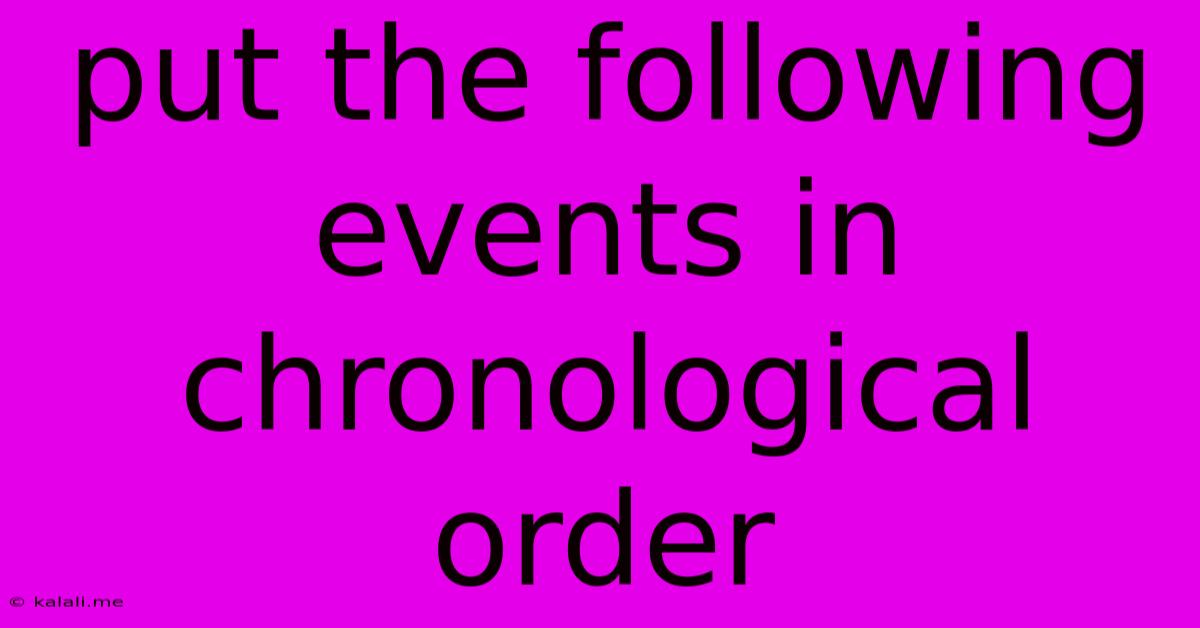Put The Following Events In Chronological Order
Kalali
Jun 14, 2025 · 3 min read

Table of Contents
Putting Events in Chronological Order: A Guide to Mastering Timelines
Organizing events chronologically is a fundamental skill, crucial for everything from writing compelling narratives to understanding historical contexts. Whether you're crafting a personal memoir, analyzing historical data, or simply trying to make sense of a busy schedule, understanding chronological order is key. This article will guide you through the process, offering tips and techniques to help you master the art of arranging events in the correct sequence.
This guide will cover:
- Understanding Chronological Order: Defining what it is and why it's important.
- Identifying Key Information: Extracting relevant dates, times, and contextual clues.
- Creating a Timeline: Various methods for arranging and visualizing chronological information.
- Troubleshooting Common Challenges: Dealing with ambiguous dates or overlapping events.
- Practical Applications: Real-world examples of using chronological ordering.
Understanding Chronological Order
Chronological order simply means arranging events in the order they occurred, from earliest to latest. Think of it as creating a timeline of events, charting their progression through time. This is essential for clarity and comprehension, particularly when dealing with complex sequences of actions or events. It allows the reader or audience to follow a clear narrative arc and understand cause-and-effect relationships. Without chronological order, information can be confusing and difficult to interpret.
Identifying Key Information: The Foundation of a Timeline
Before you can arrange events chronologically, you need to identify the key information that indicates their place in time. This usually involves:
- Dates: These are the most straightforward indicators. Pay close attention to the day, month, and year.
- Times: For events within a single day, precise times are crucial.
- Contextual Clues: Sometimes, dates aren't explicitly stated. Look for clues like references to historical events, seasonal changes, or personal milestones that can help you establish relative timelines. For instance, "before the war" or "after graduating college" provides relative chronological information.
Creating a Timeline: Methods and Visualizations
There are several ways to arrange events chronologically, from simple lists to complex visual timelines:
- Simple Lists: The most basic method, simply list events from earliest to latest. Include dates and brief descriptions.
- Detailed Lists with Descriptions: Expand on the simple list by adding detailed descriptions of each event to provide greater context.
- Visual Timelines: Use a visual representation, such as a horizontal line with events marked along it. This is particularly helpful for longer sequences of events. You can use software or even draw it by hand.
- Charts and Tables: For large datasets, charts and tables are highly effective ways to present chronological information in an organized and easily digestible format.
Troubleshooting Common Challenges: Ambiguous Dates and Overlapping Events
Sometimes you'll encounter ambiguities:
- Ambiguous Dates: If dates are vague (e.g., "sometime in the summer"), use contextual clues to estimate their position in the timeline.
- Overlapping Events: If events happen concurrently, clearly indicate the overlap. Use phrases like "simultaneously" or "while this was happening…" to clarify the relationship between the events.
- Missing Information: Acknowledge gaps in your knowledge. Don't fabricate information; instead, state clearly that the exact timing of an event is unknown.
Practical Applications: Real-world Uses of Chronological Order
The applications of chronological ordering are extensive:
- History: Understanding historical events and their impact requires a strong grasp of chronological order.
- Storytelling: In narratives, chronological order creates a clear and engaging flow.
- Project Management: Tracking project milestones and deadlines depends on chronological organization.
- Personal Diaries and Journals: Recording daily events chronologically provides a valuable record of personal experiences.
- Scientific Research: Presenting experimental results chronologically is crucial for reproducibility and understanding.
Mastering chronological order is a valuable skill that enhances clarity, comprehension, and effective communication across various fields. By utilizing the techniques outlined in this guide, you can effectively organize events in the correct sequence, ensuring that your timelines are accurate, informative, and engaging.
Latest Posts
Latest Posts
-
Which Of The Following Are Financial Statements
Jun 15, 2025
-
Which Of The Following Is Not True About Vitamins
Jun 15, 2025
-
Distance Covered Per Unit Of Time
Jun 15, 2025
-
What Is The Gpa Requirement For Lsu
Jun 15, 2025
-
Difference Between Agreement And Memorandum Of Understanding
Jun 15, 2025
Related Post
Thank you for visiting our website which covers about Put The Following Events In Chronological Order . We hope the information provided has been useful to you. Feel free to contact us if you have any questions or need further assistance. See you next time and don't miss to bookmark.